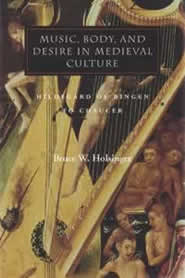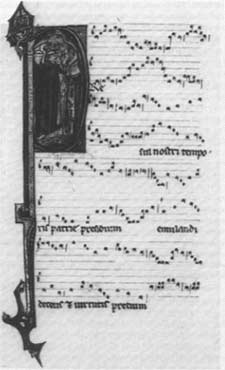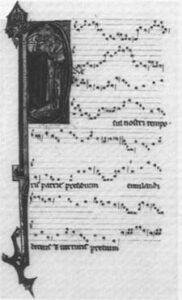Music, Body, and Desire in Medieval Culture: Hildegard of Bingen to Chaucer by Bruce Holsinger
By James Grier
 To begin at the end, Bruce W. Holsinger calls for a “musicology of empathy” in his Epilogue to this book. I would argue that all humanistic scholarship should embrace this quality, but equally that scholarship demands a good deal more than empathy. If not, then all commentary on human endeavor would lay an equal claim to the authority of criticism, as Edward T. Cone so provocatively entitled a seminal article on the subject. For, if all interpretations, or narratives, are equally valid, whose narrative will prevail? The most empathetic treatment of an issue in the realm of humanities still depends on detailed knowledge of the evidence, skillful argument, and critical acumen to provide a useful contribution to the ongoing dialogue about the human condition (see Cone and Treitler).
To begin at the end, Bruce W. Holsinger calls for a “musicology of empathy” in his Epilogue to this book. I would argue that all humanistic scholarship should embrace this quality, but equally that scholarship demands a good deal more than empathy. If not, then all commentary on human endeavor would lay an equal claim to the authority of criticism, as Edward T. Cone so provocatively entitled a seminal article on the subject. For, if all interpretations, or narratives, are equally valid, whose narrative will prevail? The most empathetic treatment of an issue in the realm of humanities still depends on detailed knowledge of the evidence, skillful argument, and critical acumen to provide a useful contribution to the ongoing dialogue about the human condition (see Cone and Treitler).
Music, Body, and Desire in Medieval Culture contains much more than empathy. In particular, it provides a very close reading of a wide range of texts from late Antiquity to the early modern period that deal with the corporeal production and reception of music. Observers and practitioners of music as diverse as Clement of Alexandria, Aurelian of Réôme, and Geoffrey Chaucer provide texts that Holsinger subjects to close scrutiny for their evidence regarding the role of music and its practices in medieval society. Some of these texts are well known to musicologists or students of literature, but few scholars of any stripe would know all of them or even the majority intimately. Scholars of literature and music, and of culture in general, will therefore find much of interest here as well as an important synthesis of many of the most colorful passages on music from the writings of this period.
Much of the language of these texts is highly metaphorical, sometimes shockingly so. In this regard, Holsinger’s achievement rests not so much on the range of literature surveyed (as impressive as that is alone) but rather on his consistently creative and critical reading of this metaphorical language. When dealing with such texts, interpretation simultaneously runs the risk of overemphasizing their literal meaning or delving too deeply into one’s subjective—not to say empathetic—reactions to them. That, of course, is the point of metaphor: to create a wealth of associations beyond the mere literal. And any author who uses metaphor invites her or his readers to invoke their own range of associations. Interpretation is necessary, even inevitable, but meaning is commensurately elusive, plural, and inescapably subjective.
Nevertheless, Holsinger argues—often passionately and usually convincingly—for a preoccupation among his authors with the corporeal aspects of music-making and consumption. His treatment is nuanced and avoids imposing a unitary vision on these texts. Still, I would raise one issue with Holsinger’s approach, which is best illustrated with an example. If we accept the Confessions of Saint Augustine as a sincere attempt at autobiography, then it is clear that Augustine had corporeal appetites that he felt needed to be controlled. But are the Confessions a sincere attempt at autobiography? If they are not, then what is the value of their testimony? Nowhere does Holsinger address this fundamental issue. To be fair, the book covers a large number of texts and authors, and Holsinger would be the first to acknowledge that all of them exist in their own historical context, as he does in his final chapter on medieval treatments of the Orpheus myth.[1]Curiously absent from this discussion is any reference to the essays in Warden, ed., Orpheus, the Metamorphoses of a Myth. A comprehensive presentation of each of these texts, with full consideration of the historical setting, would require a book many times larger than the present one. Yet, I am left with the impression that not all of the authors and texts discussed here necessarily say precisely what Holsinger would have them say.


In two central chapters, Holsinger ponders the contributions, literary and musical, of two important figures of the twelfth century: Leonin (compiler of the Magnus liber organiand musician at the cathedral of Notre Dame in Paris) and Hildegard of Bingen. Again, the literary portraits convince, as Holsinger demonstrates that both authors use language that evokes same-sex desire. His treatment of Leonin’s poetry, in particular, with his sensitive explication of Leonin’s allusions to the erotic verse of Ovid, shows compellingly that Leonin had developed a refined language of homoerotics. And Holsinger strikes a resonant chord when he invokes Elizabeth Wood’s felicitous concept “sapphonics” to characterize Hildegard’s discourse. The problems arise when Holsinger attempts to translate these findings into an investigation of the musical styles and forms these two figures practiced. [Listen to Hildegard von Bingen and Notre Dame polyphony].
Now, if metaphorical language is difficult to interpret, as mentioned above, how much more so is music? Allusive and associative rather than representational, all musical language, of whatever culture or era, depends heavily on context for its meaning. I honestly do not know whether the wide leaps in Hildegard’s melodies, which make her music so distinctive, accurately represent her sense of desire, or whether Leonin inscribed the physical passion of sodomy in the intertwined voices of his organa, and neither does Holsinger. To be sure, these gestures mean something—to Hildegard and Leonin, to their contemporaries, and to modern listeners, including myself, Holsinger, and the readers of this journal. But what do they mean? Can we know, with any certainty, how Hildegard and Leonin conceived of them? Why should Holsinger’s reading of them be any more authoritative than anyone else’s?
Here is the point at which a “musicology of empathy” breaks down. For the danger is not that we would become the historical figures we study so closely. Identification with subject, and sometimes over-identification, is a widespread occurrence in humanistic research. Ethnomusicology (from ethnography) has given us a powerful tool for understanding it in the recognition of the phenomenon of participant observation. Instead, the danger is that those historical figures, silenced by time and entirely dependent on us to be their voice, become us.
I close with an indictment of the series in which this book appears and its distinguished press. The cogency of much of Holsinger’s argument depends on his documentation. To give one example, although he freely avails himself of published translations in his interpretation of the primary texts (and no one, least of all me, would criticize him for doing so in view of the wide range of literature in a number of languages he covers), he has rarely stopped there. Virtually every quotation, if not in the original language, as it often is, is supported by a reference to an edition in the original, and the published translations are always reviewed in light of Holsinger’s own appraisal of the text in the original. But no one would know that without flipping to the back of the book and excavating the note that conveys this information. A critical book like this one needs critical readers, and critical readers want and need to know the basis for Holsinger’s sometimes controversial and always provocative interpretations. There is absolutely no excuse nowadays for printing the notes at the end of a book. If I can put them at the bottom of the page with a five-year old laptop running ten-year old software, then Stanford University Press ought to be able to do it. This practice does an equal disservice to author and reader. Some of the principal strengths of this fine book, then, lie hidden under a bushel through no fault of the author.
James Grier
Edward T. Cone Member in Music Studies, School of Historical Studies, Institute of Advanced Study
University of Western Ontario
Works Cited
Cone, Edward T. “The Authority of Music Criticism.” Journal of the American Musicological Society 34 (1981): 1–18.
DeWalt, Kathleen M. and Billie R. DeWalt. Participant Observation: A Guide for Fieldworkers. Walnut Creek, CA: AltaMira Press, 2002.
Treitler, Leo. “Gender and Other Dualities of Music History.” Musicology and Difference: Gender and Sexuality in Music Scholoarship. Ed. Ruth A. Solie. Berkeley: University of California Press, 1993. 23–45.
Warden, John, ed. Orpheus, the Metamorphoses of a Myth. Toronto: University of Toronto Press, 1982.
Wood, Elizabeth. “Sapphonics.” Queering the Pitch: The New Gay and Lesbian Musicology. Ed. Philip Brett, Elizabeth Wood, and Gary C. Thomas. New York and London: Routledge, 1994. 27–66.

